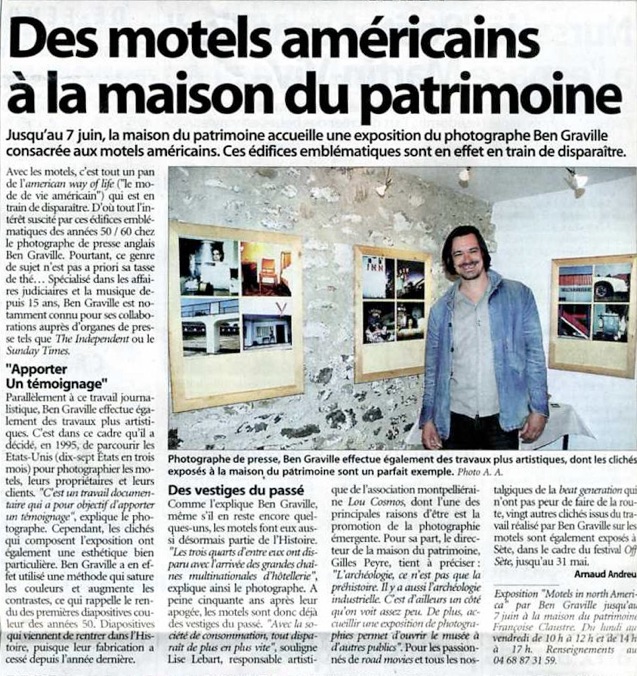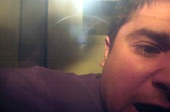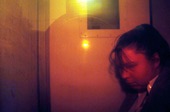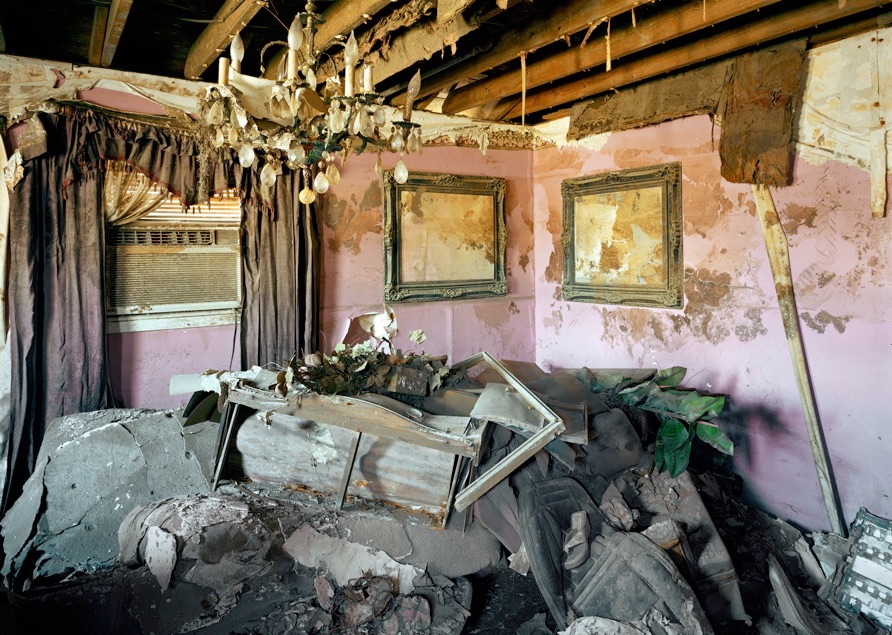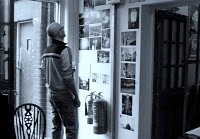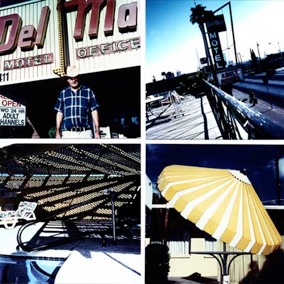Royal Academy Summer Exhibition
2010 14th June - 22nd August 2010
Pilloried and praised in equal measure, but there's no disputing the popularity of the
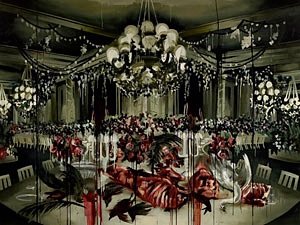
Royal Academy's Summer Exhibition. Showing annually since 1769, it's the world's largest (and oldest) submissions-based contemporary collection and features up-and-coming artists alongside notable names such as Michael Landy, Tracy Emin and Gillian Ayres.
With such a range of subject matter, style and mediums on show there is little sense of cohesion, despite the fact it runs under a theme, which this year is "Raw". What matters though, is that there really is 'something for everyone' and there certainly should be with over 1200 pieces displayed.
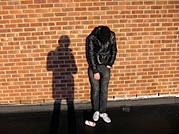
The real joy of the show is discovering your own personal gem, whether your taste is for the contemporary or the conservative. Oh, and if you have a few grand to spare, you can even purchase your new find. Just make sure you put your orange dot in the right place.
Here are a few of my own standouts, from this year's show:
"Poverty Party at The White House" by Rosson Crow - £Not For Sale
The implication of a busy, celebratory scene that somehow manages to be strangely desolate
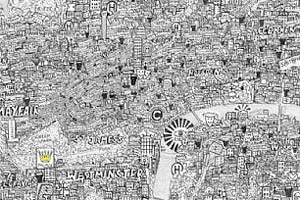
and remote. Dead birds adorn the table alongside red roses which drip and bleed down the canvas. Unsettling.
"Chicken Shop Chic" from the series "The Less We Have The Cheaper The Party" by Ben Graville £295
An ordinary, drunken moment becomes a scene set on stage. The brick wall forming the backdrop and the man appearing to be centre stage in the spotlight. Although the photographer appears to be part of the audience, he is showing affinity by attempting to become part of his subject. Humorous and quirky.
"Hub 2007 - 10" by Stephen Walter £2,300
Beautifully intricate pictorial map of London. Tiny little symbols representing hospitals, supermarkets, houses and even familiar London landmarks are crammed in with not a sliver of space remaining. Both informative and humorous, this piece relies on a long, lingering viewing to truly appreciate the work.
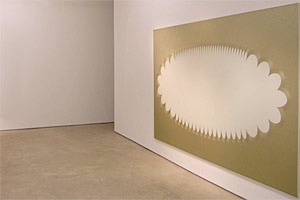
"Divine" by Jane Harris £21,050
Big, bold and beautiful. The overlaid brushwork and elliptical form of this painting creates a sense of movement which is at odds with its initial appearance of symmetry. Walk around it and see.
The exhibition continues, until the 22nd of August.
Royal Academy of Arts, Burlington House, Piccadilly, London W1J 0BD
Piccadilly Circus or Green Park Tube.
One of the most common conventions of portraiture is that the subject is looking at the viewer or, at the very least, aware that they are being observed and have give their consent to being photographed. This very idea is challenged in Ben Graville's series In and out of the Old Bailey. While working for a press agency, Graville photographed through the windows of prison vans while waiting to take remand prisoners into court. The intriguing snap-shots reveal a very secretive and forbidding space inside the vans, dominated by the prisoners who betray a variety of emotions and personalities. Due to the unpredictability of this process, Graville's images are chaotic and at times abstract. Graville doesn't even fill the frame with the subjects, which only adds to the sense of stress and false bravado of the prisoners who are facing up to the camera.



In and out of the Old Bailey
by Ben Graville



Ben Graville's series also highlights how the conventional idea of representing the face alone within a portrait can be extended to recording other parts or aspects of the body. Wiebke Leister photographed children being tickled with unpredictability strangely similar to that of Graville. In her series, Neck Over Head the children photographed at high speed show, with their bodies as well as their facial expressions, a variety of postures and contortions that seem in some ways peculiar. Leister's series is unsettling to viewers as it is difficult to decide whether the children are in a state of hysteric laughter, or in fact crying out in pain. This work reminds us of how the camera is able to freeze a split-second moment with amazing visual clarity, but it also shows us that the photograph has limitations in that the true, original content of the moment depicted can easily be taken out of context to tell a different story.
© Photoworks - www.photoworksuk.org
Andy O’Connell:
The Estate We’re In
Text by Gordon MacDonald
Photographers using photography
My first job after moving to London as a seventeen-year-old was at the Old
Bailey as a photographer for a freelance press agency. The job was very simple
and suited a teenager with a decent level of fitness and an appreciation of basic
photographic technique. Every morning I stood three hundred metres from the
back door of the Bailey, dressed in a suit and rubber-soled shoes; holding a
Nikon FM2, which was fitted with a wide-angle lens, a motor drive and giant Metz
flashgun. I would wait for a prison van to appear from around a corner some
hundred meters further down the road and start to run towards the courtrooms.
By the time the van had caught up with me I was in full sprint, and, with the
camera held above my head, I was able to photograph one frame through each
window of the vehicle. The wide view of the lens would catch everyone inside
the van and the flash illuminated the prisoners brightly and precisely. After
many of these strange performances, the rest of the day was spent processing
the film and then sitting in the courtrooms listening to cases whilst marking
off the names of the defendants against the faces on the contact strips. The
good ones – the murderers, rapists, or thieves whose crimes were vicious or
bungled or heart-warming enough to merit interest – would be made up as prints
and rushed to the national daily newspaper picture desks on Fleet Street. We
were the paparazzi to the criminal classes: a group of young men admired and
hated in equal measure, spat at and hit by family members; cheered by passing
motorists and helped out by prison guards, who would lift a covering blanket or
get in frame with a thumbs-up or some finger-rabbit ears to lift the content of
the image.
Some quarter of a century on and I am the editor of this magazine - a long
way from these levels of teenage fitness and performing a role that couldn’t
be much different. The submissions procedure for the magazine is open to all,
and sometimes throws up the unexpected. The most simultaneously confusing
and enlightening submission of recent months has been a set of pictures of
prisoners in vans entering the Old Bailey. They were submitted by Ben Graville
as a folio of images to be considered for publication and critical attention, and
are some of the most powerful portraits I have been sent whilst working on the
magazine. They did not look like press images, though they were the same kind
of pictures I had been taking for Fleet Street twenty-five years earlier. Something
had changed in the interim – postmodernism had worked on my understanding
and the digital age had made photography even more prevalent. Why had those
pictures meant one thing back then, but had another quite different meaning
now?
Liverpool's First International Photography Festival: Look11, Various Venues, Liverpool.
Review by Kenn Taylor
A new entry on Liverpool’s cultural calendar, Look11, is a vast photography festival encompassing exhibitions, events and projects taking place over several months. Like the similar but larger Liverpool Biennial, it has taken over many of the city’s arts venues for the duration and has an over-arching theme – ‘photography as a call to action’.
Open Eye Gallery has been promoting photography in Liverpool since it was founded in the 1980s. This will be the last exhibition in the Wood Street space that it has occupied since the early 90s, before it moves to a new, larger home on the waterfront. Appropriately, the exhibition features images chosen from Open Eye’s archive, curated by American photographer, Mitch Epstein, who will have his first UK solo show at their new space.
The shots are very much of their time, nearly all from the 1980s; they feature some of the most influential British photographers of the period, many of whom cut their teeth in Liverpool, including Tom Wood and Martin Parr. The lives of the working-class and the decaying fabric of the industrial north are the inevitable main themes of many of the images, with photographers like John Davies and Parr finding truth and beauty where others would see only ugliness and squalor. It’s a timely show, and you wonder what such photographers would think of Liverpool’s startling regeneration, and the Open Eye’s shiny new home.
Bluecoat has perhaps the most successful exhibition of the festival overall. Taking Containment as their own theme within a theme, the show is varied, but high-quality and coherent. Ben Graville’s In and out of the Old Bailey(2002-09) features ‘papped’ shots taken of prisoners through the mirrored glass of prison vans on their way into the UK’s central criminal courts. The images raise issues of privacy, media intrusion and voyeurism. Beyond this though, their power as portraits is undeniable; the garish colours, lack of focus and the candid poses, some defiant, others cowering, adding to their disconcerting fascination.
In total contrast, David Maisel’s project, Library of Dust (2006), records the corroded copper containers that hold the cremated remains of patients who died whilst in the Oregon State Mental Asylum. Dating from between 1883 and the 1970s, these ashes were never collected by the families of the deceased. The large and vivid images detail the copper decaying in rich greens and whites, only the faded institutional labels revealing their true grim purpose. That these works highlight the containment not only of human remains, but those who society deems as ‘other’, so much so that many were rejected by their own families even in death, is as poignant as it is troubling.
The vast Novas Contemporary Urban Centre is, as usual for festivals like this, filled to the brim with several different exhibitions. Its basement crypt holds the largest exhibition, which appears to have a documentary focus. Robert Polidori’s New Orleans After the Flood (2005-6) is a series of large images of the destruction wrought on domestic environments by Hurricane Katrina. Featuring the bright colours of family homes wrecked with the dank grey floodwater and filth, the images are shocking in their epicenes and fascinating in there detail.
On an even larger scale, are Ed Burtynsky’s trademark large-format photographs of landscapes altered by man. Oil Spill (2010) taken after last year’s Deepwater Horizon disaster in the Gulf of Mexico, are some of his most recent images and, like so much of his work, are stunningly aesthetic in there approach, but terrible when you consider what they feature. His black and white images of ship-breaking in Bangladesh meanwhile, are even more gripping, featuring dirty, dishevelled human figures in a mess of mud and rotting metal, overwhelmed by the vast vessels they are dismantling. Closer to home, Ian Beesley’s shots from Hay Royds Colliery in Yorkshire highlight that similarly dirty work continues in the UK, despite what many think.
These are just three of the shows in Look11, whose venues encompass everything from Café walls to the city’s main Walker Art Gallery. It's interesting to consider these exhibitions under the umbrella of 'photography as a call to action' as while many of the photographers share this aim, many don't, instead wanting to represent the world in a certain way, a world that is complex and multifaceted. Aided by the curators decision to show differing work in pairs, or at least close context which helps to create dialogue and ask questions of different images and photographers, rather than presenting any views as a singular truth.
Look11 is an impressive programme and a must see for anyone with an interest in documentary photography. Despite the cuts to ACE funding, it's exciting to see Artistic Director, Stephen Snoddy and Festival Manager, Daniel Cutmore's vision come to the fore and it's even more exciting to think, about what this festival could develop into over the next few years, continuing to use photography as a tool to examine our complex, ever-shifting world.
Look11 continues until 26 June in various venues across Liverpool.
The Image / Incarceration / Representation / Media / Social Justice / Responsible Photography
In & Out the Old Bailey by Ben Graville. ‘The Photo Booth from Hell’
June 13, 2009 in Press | Tags: Ben, Ben Graville, Flash, Graville, London, Metropolitan, Metropolitan Police, Old Bailey, Portraits, Press Photography, Prison Trucks, Remand Prisoners, Vans
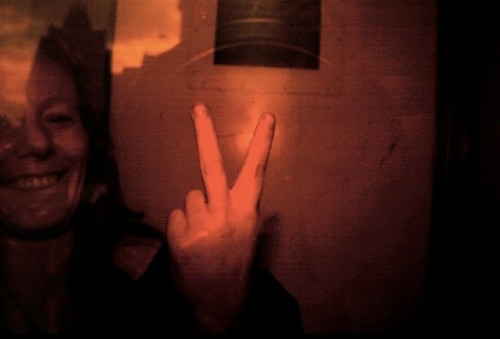
I grinned ear to ear yesterday when Foto8 In & Out the Old Bailey ran Ben Graville‘s work of remand prisoners (and security guards) in reaction to the press camera up against reinforced glass. It is a novel, clear and entertaining project. Why did it take someone so long to put a series like this together?
If photography is – in cases – intended to plumb the human soul and aggressively seek out human frailty, pride, conversion, obstinacy, etc., then the back of a cop-van is probably a good place to start. Folk on their way to trial are going to have a lot to say about a) their charge b) their case c) everything else that the first two don’t cover.
James Luckett over at consumptive coined the term “Photo booth from Hell” and he’s right on the money. They sit in a big white box subject to a camera behind a small glass rectangle. The environment is claustrophobic, impersonal and germy.
If a prisoner has the forethought or experience they may ready him or herself for the photograph. If not they’ll be captured on film anyway.
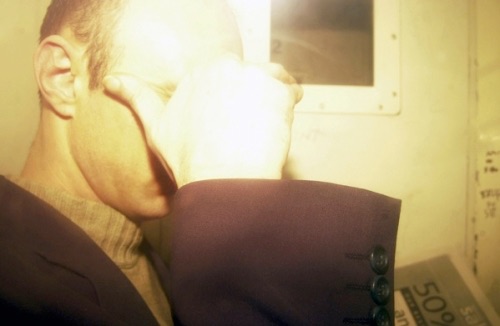
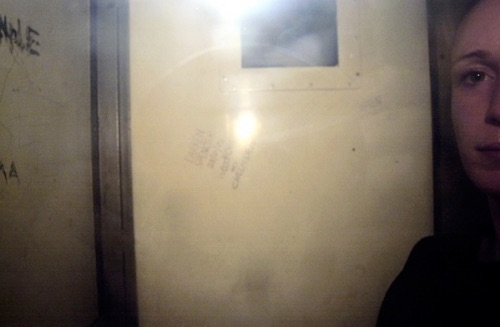
How balanced is the interaction between camera and subject? The image will serve the media more than it will serve the balance or accuracy of the court case. But this is a truism.
Graville is interested in state enforced anonymity and the effect it has on mystifying and intensifying understanding;
It should be no shock that many prisoners perform, gurn and address Graville’s camera directly; they are – literally and legally – in a transitory, undecided state. If I was in this same situation, I think it would be a natural reflex-come-obligation to self-represent to the camera. These prisoners may not have chosen to have the camera in their space, but they have the choice of how to address it.
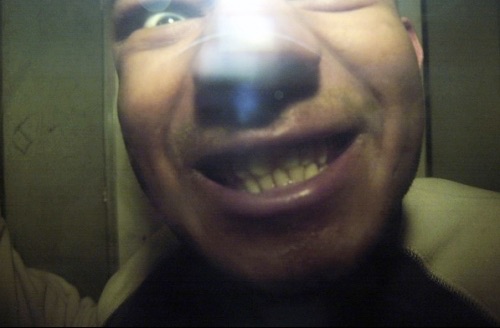
… and of course there’s always a security guard who gets in on the action.
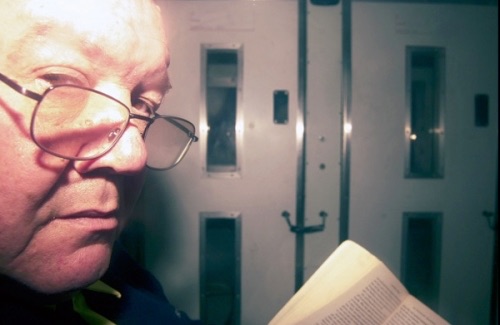
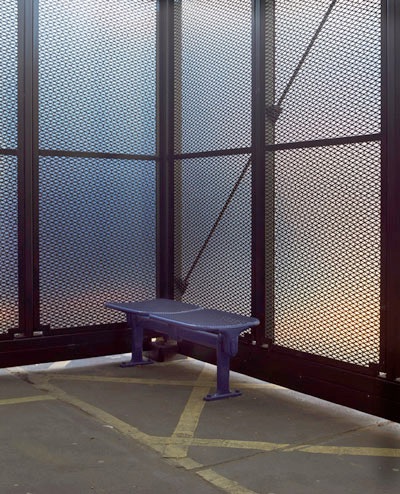
Look 11: International Photography Festival
CONFINED, featuring Juergen Chill (Ger), Edmund Clark (UK), John Darwell (UK), Dornith Doherty (US), Ben Graville (UK), David Maisel (USA) and David Moore
Free, no ticket required
Seven artists from across the world will explore confinement in contemporary life at the Bluecoat between Sat 14 May and Sun 10 July as part of the city’s first ever photography festival.
The theme of Look 11 is ‘photography as a call to action’ – the role of photography in questioning, documenting and responding to global issues of social justice.
Four of the Bluecoat’s artists are concerned with the confinement of humans: Juergen Chill’s photographs of German prison cells are architectural studies of the physical space prisoners inhabit; Edmund Clark’s photographs of Guantanamo illustrate three views of ‘home’ in the context of political imprisonment; David Moore explores surveillance through an investigation of Paddington Green High Security Police Station where terror suspects are held under the Counter Terrorism Act; and Ben Graville’s penetrating and provocative portraits capture prisoners being driven to and from the Old Bailey.
John Darwell’s new photographic series Dogs in Cages, commissioned by the Bluecoat, is an allegory on incarceration. Produced in cooperation with one of the North West’s largest dogs homes, the work highlights the nature and mechanics of captivity.
Dornith Doherty has collaborated with leading biologists to photograph at seed banks, including the one at Kew, responding to the collection process, containment of biological species and global efforts to insure against starvation. David Maisel documents cremated remains of psychiatric patients collected since the late 19th century. Abstract and elegiac, the photographs provoke discussion about loss, memory, confinement and mental illness.
Sara-Jayne Parsons, Exhibitions Curator at the Bluecoat said: “The work included in our exhibition explores several different interpretations of physical and psychological confinement in contemporary life. We’ve tried to create juxtapositions within the show that will lead our audience to consider the complex relationship between justice, ethics, a duty of care and compassion – a fundamental relationship that affects “captives” and “keepers.”
Look11’s Artistic Director, Stephen Snoddy, said: “Photography has the power to frame and represent debate, to capture events in a way the written word cannot. This summer we want people to think about how photography works as a medium. The message is ‘stop, think, examine and debate’.
As well as exhibiting works across Liverpool at the city’s largest arts venues and spaces by the UK’s leading photographers and artists we want people to pick up a camera themselves. Photography is increasingly democratic. We all have cameras in our pockets now, this summer we want to explore what they can do and what people have to say with their photos”.
Exhibition tour with the artists and curator
May 14, 2pm, Galleries, ticketed but free
Artist talk – Edmund Clark
June 2, 6-7pm, Galleries, ticketed but free
When the Light Goes Out: Edmund Clark, Omar Deghayes & Erwin James
June 2, 7.30-9pm, Performance Space, ticketed but free
Responding to Edmund Clark’s photographs in the Bluecoat exhibition Confined, former prisoners Omar Deghayes and Erwin James discuss their experiences of incarceration.
Artist talk – John Darwell
June 16, 6-7.30pm, ticketed but free
Photographer Ben Graville in conversation with Sara-Jayne Parsons, Exhibitions Curator
July 7, 6-7.30pm, ticketed but free
Fri 13 – Sun 15 May
The National Photography Symposium
Established by photography network Redeye, the National Photography Symposium is the place for photographers to gather and talk about key issues of the moment. It takes place in a different venue each year, this year at the Bluecoat as part of Look11. ‘The most important forum in UK photography’ (Francis Hodgson, Financial Times), it offers a range of presentations, panel discussions and practical sessions, plus opportunities to meet, chat informally and look at photography.
Further details: Redeye www.redeye.org.uk
National Photography Symposium http://uknps.org.uk
Encounters with strangers: Pete Carr
May 13-June 14
Encounters with strangers features portraits of strangers – nothing unusual there perhaps. However instead of displaying these portraits in the traditional manner in a gallery, the photographer is using social media to let the public encounter each photo out on the street in the location where it was taken.
Anyone with a smartphone will be able to download a free map that takes them out of the Bluecoat and onto the streets of Liverpool and the Wirral to find the photographs. You will only be able to see each photograph and read about the person in it when you are in the right location.
Artist talk – Pete Carr
June 8, 7-8pm, Bistro, ticketed but free
Until 10 July (Extended) Daily 10.00am-6.00pm
Sharon Mutch: Solitary Sitting Rooms
In response to the confined theme, photographer Sharon Mutch, based at the Bluecoat, investigates voluntary and involuntary confinement. Her photographic installations look beyond the street to construct a narrative of interiors, concentrating on residents who are seldom seen. Here, the lens is not pointed at the confinee, but becomes their eyes, and what we view in the photographs are isolation, confusion, daydreams – instruments of contact with the outside world. Everything is not as it seems, as we discover that interwoven within the photographs are portals to the past that create an escape from daily reality.
Free
Exposition : Du samedi 06 mai 2006 au dimanche 14 mai 2006
Auteurs : Ben Graville.
Les Boutographies - Rencontres Photographiques de Montpellier
Téléphone (+33) 619 291 784
Site web www.boutographies.com
Email contact@boutographies.com
Association Grain d'Image
140 rue du Pioch de Boutonnet
Résidence le Jardin aux fontaines - Bat A3
34090 Montpellier
France
Festival : 6ème Rencontres Photographiques de Boutonnet-Montpellier
Du 06 au 14 mai 2006
Du samedi 06 mai 2006 au dimanche 14 mai 2006
Les Boutographies - Rencontres Photographiques de Montpellier - 34090 Montpellier
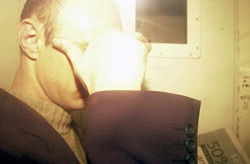
Ben Graville photographie des prévenus lors de leur transfert, en fourgon cellulaire, vers le palais de justice de Londres. Il nous montre ces gens au moment où ils sont soustraits à la société et à la vue. Quand il donne, au travers du hublot du fourgon, le coup de flash qui expose ces bannis à la lumière, Ben Graville commet l’exhibition de ce qui est caché. Il viole la loi tacite qui les exclut du regard et, dans le même temps, se soumet à notre désir de tout voir. Mais son acte photographique n’est pas seulement celui de l’index qui désigne ce qui était maintenu caché, il montre un au-delà de ce désormais visible, vers le vide qui s’est créé autour de ces êtres en rupture de monde.
photographie.com : 2006-05-06
It's all happening at the Old Police Station. Last night saw the opening of Ben Graville's photo exhibit, Deptford's Dreaming, in the Metropolitan Tea Rooms. The word "characters" was used a lot in the conversation of guests, as they pointed out local figures of renown or notoriety. Tea Rooms boss Jaine Laine, who presides over the yet-to-be realised Deptford Museum, which will eventually house Graville's photos, struck a sombre note as she lit a candle to honour one subject who was murdered. Graville's eye is drawn to the more marginal areas of life, the "before", rather than the "after" of local gentrification. Photos of security tags on clothes, drug paraphernalia and piles of rubbish probably aren't the face that the local authorities wish to showcase, but they reflect a scruffy defiance of homogenisation.
As guests mingled inside, perusing the pictures and quaffing wine, outside in the courtyard an array of "characters" was drawn to the window, through which the England game played on the tiniest of TVs. Rain fell, a vuvuzela was tooted and one man played guitar as a discordant accompaniment. Extraordinary.
The courtyard houses a collection of freight containers-turned-rehearsal spaces, one of which is now a recording studio, having been opened by royalty-in-residence Jaine Laine last week. The newly dubbed Amersham Vale Studios hosted its first session, as Berlin one-woman-band Golden Diskó Ship recorded five songs for my show on Optical Radio. The session will air next month. I could not be prouder, as it has been my aim to get more live music on the show, another step in our upward surge and, well, scruffy defiance of homogenisation.
Deptford Museum: Ben Graville continues 7th July
A collection of over 100 works by this talented photographer covers the walls of the Café space. Graville has a unique ease of capturing scenes and local characters resulting in images both democratic and elegant without resorting to familiar clichés of street photography.
Striking work by Ben Graville (www.bengraville.co.uk) is positioned just inside the front door. It feels very simple in form, clean, full of meaning - and interpretation. A hoody leans against a brick wall, Red Stripe lager-can and plastic cup at his feet; a dark figure reflected on a wall faces him. It's called The Less We Have The Cheaper The Party from the artist's Chicken Shop Chic Series. It registers on many levels politically and socially (tailor-made for an underage-binge-drinking campaign); the most thought provoking and well-considered piece of the exhibition. Ben Graville's hoody remains the lasting image after the exhibition.

